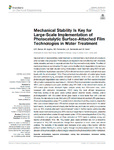Mechanical Stability Is Key for Large-Scale Implementation of Photocatalytic Surface-Attached Film Technologies in Water Treatment

Use este enlace para citar
http://hdl.handle.net/2183/35565Colecciones
- Investigación (FCIE) [1234]
Metadatos
Mostrar el registro completo del ítemTítulo
Mechanical Stability Is Key for Large-Scale Implementation of Photocatalytic Surface-Attached Film Technologies in Water TreatmentAutor(es)
Fecha
2021-10-18Cita bibliográfica
Ramos D, Iazykov M, Fernandez M, Santaballa J and Canle M (2021) Mechanical Stability Is Key for Large-Scale Implementation of Photocatalytic Surface-Attached Film Technologies in Water Treatment. Front. Chem. Eng. 3:688498. doi: 10.3389/fceng.2021.688498
Resumen
[Abstract] Replacement of classical tertiary water treatment by chemical-free sunlight-driven photocatalytic units has been often proposed. Photocatalysts are required to be cost-effective, inert, chemically stable, reusable, and easy to separate and also that they are mechanically stable. The effect of mechanical stress on a photoactive TiO2 layer, and on its effectivity for degradation of phenol as a model pollutant, has been studied during photocatalytic water treatment using NUV–vis light. Sol–gel (SG) and liquid phase deposition (LPD) methods have been used to coat spherical glass beads with the photocatalyst (TiO2). Physicochemical characterization of coated glass beads has been performed by N2 adsorption–desorption isotherms, SEM, EDXS, and AFM. Phenol photocatalyzed degradation was carried out both in stirred batch and flow reactors irradiated with a medium-pressure Hg-vapor lamp (λ > 350 nm). Phenol concentration was determined by HPLC, and its photoproducts were identified using HPLC/MS. In the stirred batch reactor, all LPD-coated glass beads displayed higher catalytic activity than SG-coated ones, which increased with calcination temperature, 700°C being the most efficient temperature. Preliminary etching of the glass beads surface yielded dissimilar results; whereas, phenol photodegradation with SG-coated etched glass beads is twice faster than with unetched SG ones, the rate reduces to one-third using LPD etched instead of unetched LPD glass beads. Phenol photodegradation using LPD is similar both in stirred batch and flow reactors, despite the latter uses a lower catalyst load. LPD-etched catalyst was recovered and reused in the stirred batch reactor; its activity reduced sharply after the first use, and it also lost activity in successive runs, ca. 10% of activity after each “use and recover” cycle. In the flow reactor, activity loss after the first experiment and recycling (ca. 30%) was much larger than in the following runs, where the activity remained rather constant through several cycles. LPD is more adequate than SG for TiO2 immobilization onto glass beads, and their calcination at 700°C leads to relatively strong and reactive photocatalytic films. Still, TiO2-coated glass beads exhibited very low photoactivity compared to TiO2-P25 nanoparticles, though their separation is much easier and almost costless. The durability of the catalytic layer increases when using a flow reactor, with the pollutant solution flowing in a laminar regime through the photocatalyst bed. In this way, the abrasion of the photocatalytic surface is largely reduced and its photoactivity is better maintained.
Palabras clave
Photocatalysis
Supported photocatalyst
Coating
Flow photocatalysis
Mechanical stability
Heterogeneous photocatalysis
Supported photocatalyst
Coating
Flow photocatalysis
Mechanical stability
Heterogeneous photocatalysis
Versión del editor
Derechos
Atribución 4.0 Internacional
ISSN
2673-2718






